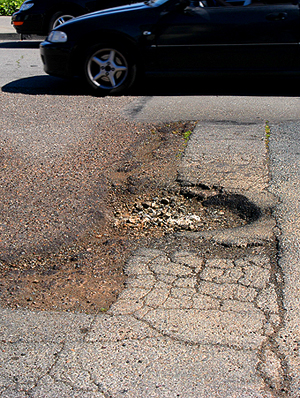The street condition ratings by city are listed at www.mtc.ca.gov/news/street_fight/pci_2014.htm. Richmond is in the “Fair” category, with scores of 61 for 2012, 65 for 2013 and 64 for 2-14. The expectation is that funds for Measure U will give us a boost, but the timing and magnitude is still up in the air pending 2015-16 budget preparation.
Tom Butt
Local Streets & Roads No Better, But No Worse
Regional Pavement Quality Average Unchanged for Sixth Consecutive Year
Contacts:
John Goodwin, (510) 817-5862
Randy Rentschler, (510) 817-5780
See also:
- Street Fight
A special multi-media report on the ongoing battle for better Bay Area pavement.

OAKLAND, Calif., April 13, 2015…The good news is the quality of the pavement on the typical Bay Area street did not deteriorate in 2014. The bad news is that neither did it improve. Data released today by the Metropolitan Transportation Commission (MTC) show the region’s nearly 43,000 lane-miles of local streets and roads registered an average pavement condition index (PCI) score of 66 out of a maximum possible 100 points last year, as calculated on a three-year moving average basis. This marks the sixth consecutive year the region has recorded an average PCI score of 66, a condition deemed “fair” but which also indicates that the asphalt shows serious wear and likely will require rehabilitation soon.
“One of MTC’s long-held goals is to get the local street or road network in every one of our cities and counties to a PCI score of 75 or better,” noted MTC Chair and Santa Clara County Supervisor Dave Cortese. “We can take heart that we’re not losing ground, but we have a long way to go and still have a lot of work to do before this goal can be met.”
PCI scores of 90 or higher are considered “excellent.” These are newly built or resurfaced streets that show little or no distress. Pavement with a PCI score in the 80 to 89 range is considered “very good,” and shows only slight or moderate distress, requiring primarily preventive maintenance. The “good” category ranges from 70 to 79, while streets with PCI scores in the “fair” (60-69) range are becoming worn to the point where rehabilitation may be needed to prevent rapid deterioration. Because major repairs cost five to 10 times more than routine maintenance, these streets are at an especially critical stage. Roadways with PCI scores of 50 to 59 are deemed “at-risk,” while those with PCI scores of 25 to 49 are considered “poor.” These roads require major rehabilitation or reconstruction. Pavement with a PCI score below 25 is considered “failed.” Among the region’s three largest cities, San Jose (62) and San Francisco (66) both recorded three-year scores in the “fair” range, while Oakland (59) dropped into the “at-risk” category.

The Contra Costa County city of Brentwood and the Alameda County city of Dublin topped the list of Bay Area pavement rankings for the 2012-14 period, with both cities reporting average PCI scores of 86. Other cities with PCI scores in the “very good” range include Belvedere (80), Clayton (80), El Cerrito (84), Foster City (81), Portola Valley (80) and Union City (81). The lowest-ranked pavement in the Bay Area was found in the Marin County city of Larkspur, which recorded a PCI score of 40 for 2012-14. Larkspur officials expect new funding sources and innovative pavement design and construction strategies to boost the city’s PCI score in the coming years.
“The primary focus of (our) pavement improvement effort has been to improve residential streets,” explained Mary Grace Houlihan, Public Works Director for the City of Larkspur. “In 2012, the city implemented a vehicle impact fee for garbage trucks to offset the increased road maintenance costs generated by these vehicles, and in 2013 voters approved Measure C, which added a half-cent general sales tax on each dollar of taxable sales in the city. Following the Measure C vote, the city council passed a resolution to apply the majority of the new sales tax revenue to local road rehabilitation. For fiscal 2014-15, 95 percent of the Measure C revenue was committed to local road rehabilitation.”
In addition to Larkspur, other jurisdictions with three-year average PCI scores in the “poor” range include Orinda (49), Petaluma (45), St. Helena (45), Vallejo (47), and unincorporated Sonoma County (45).
MTC’s Regional Streets and Roads Program later this year will recognize Union City for having the best overall pavement management strategy of any jurisdiction in the Bay Area. The southern Alameda County city boosted its one-year average PCI score to 83 in 2014 from 79 the year before. The Regional Streets and Roads Program also will recognize Dublin for the continuing high quality of its local street network and unincorporated Contra Costa County for chalking up a five-point improvement in the one-year PCI score on its extensive road network, to 73 in 2014 from 68 in 2013.
The complete 2014 Bay Area Pavement Conditions Summary — including percentages of local roadways in “excellent” or “very good” and “poor” or “failed” condition, and a listing of average PCI scores for the arterials, collector roadways and residential streets — in all Bay Area counties and cities is available at www.mtc.ca.gov/news/street_fight/pci_2014.htm. Those interested in a deeper look at the challenges facing the region’s local street and road network are invited to visit the MTC website at www.mtc.ca.gov/news/street_fight/ and click on the link for a 2014 multimedia piece entitled “Street Fight: The Ongoing Battle for Better Bay Area Pavement.”
MTC is the transportation planning, financing and coordinating agency for the nine-county San Francisco Bay Area.
|

